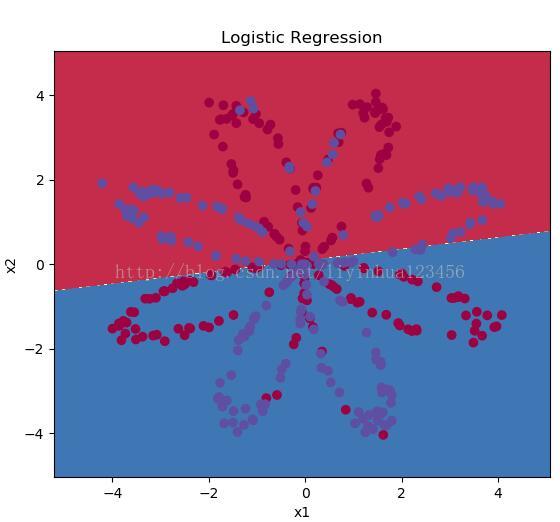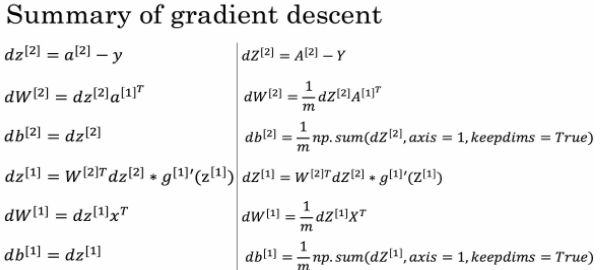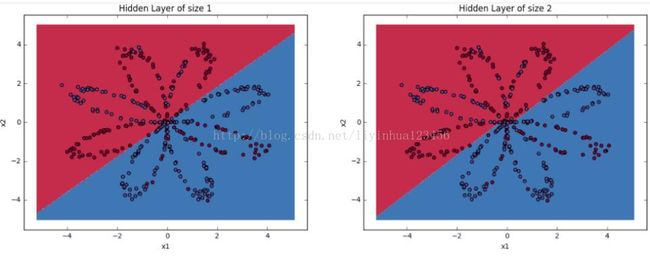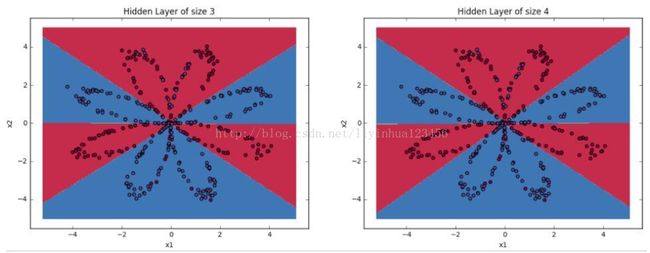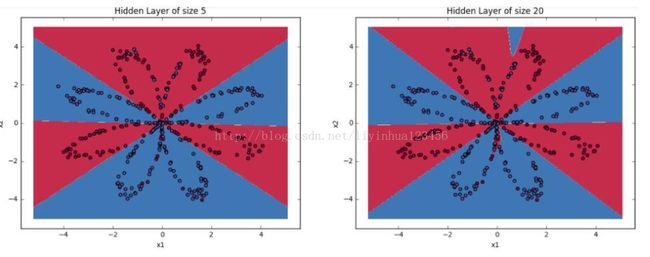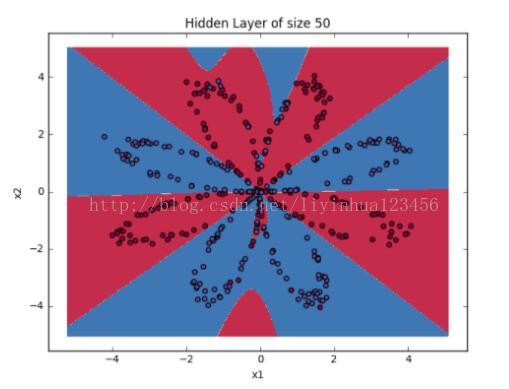吴恩达深度学习第三周作业(Planar data classification with one hidden layer)
本次实现具有一个隐藏层的神经网络
1.导入需要使用的库
import numpy as np from testCases import * import matplotlib.pyplot as plt import pylab import sklearn import sklearn.datasets import sklearn.linear_model
2.我们使用一个函数load_planar_dataset()加载数据集,该函数如下:
def load_planar_dataset(): np.random.seed(1) m = 400 # 样本数量 N = int(m / 2) # 每个类别的样本量 D = 2 # 维度数 X = np.zeros((m, D)) # 初始化X Y = np.zeros((m, 1), dtype='uint8') # 初始化Y a = 4 # 花儿的最大长度 for j in range(2): ix = range(N * j, N * (j + 1)) t = np.linspace(j * 3.12, (j + 1) * 3.12, N) + np.random.randn(N) * 0.2 # theta r = a * np.sin(4 * t) + np.random.randn(N) * 0.2 # radius X[ix] = np.c_[r * np.sin(t), r * np.cos(t)] Y[ix] = j X = X.T Y = Y.T return X, Y
调用该函数,可以将图像显示出来:
我在写到此处时,出现了一个bug,按照网上写的是c=Y,发现存在维度不同的问题,此处X[0 , :]维度是(400,), Y维度为(1,400),
报错为:c of shape (1, 400) not acceptable as a color sequence for x with size 400, y with size 400
然后我利用Y.reshape(X[0,:].shape),把c的维度也变成了(400,),虽然老师说我们要尽量少使用(400,),这种秩为1的数组,但是我此处把c 使用reshape为(400,)
X,Y=load_planar_dataset() plt.scatter(X[0, :], X[1, :],c=Y.reshape(X[0,:].shape), s=40, cmap=plt.cm.Spectral); plt.show()
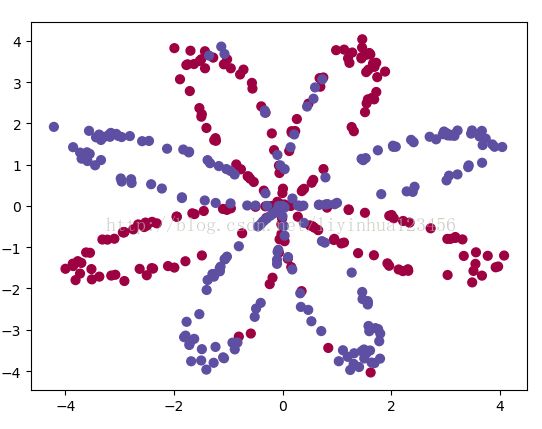
对于y=0时,显示为红色的点;而当y=1时,显示的是蓝色的点。
我们的目标是把这两种颜色点分开
查看训练集的维度
shape_X=X.shape shape_Y=Y.shape m=X.shape[1] print("the shape of X is:"+str(shape_X)) print("the shape of Y is:"+str(shape_Y)) print("the training examples:" +str(m))首先我们调用sklearn的内置函数来实现简单的逻辑回归来对这些点进行二分类
clf = sklearn.linear_model.LogisticRegressionCV(); clf.fit(X.T, Y.T); plot_decision_boundary(lambda x: clf.predict(x), X, Y) plt.title("Logistic Regression") # Print accuracy LR_predictions = clf.predict(X.T) print ('Accuracy of logistic regression: %d ' % float( (np.dot(Y, LR_predictions) + np.dot(1 - Y, 1 - LR_predictions)) / float(Y.size) * 100) + '% ' + "(percentage of correctly labelled datapoints)") #Accuracy of logistic regression: 47 % (percentage of correctly labelled datapoints)其中plot_decision_boundary的实现如下:
def plot_decision_boundary(model, X, y): # Set min and max values and give it some padding x_min, x_max = X[0, :].min() - 1, X[0, :].max() + 1 y_min, y_max = X[1, :].min() - 1, X[1, :].max() + 1 h = 0.01 # Generate a grid of points with distance h between them xx, yy = np.meshgrid(np.arange(x_min, x_max, h), np.arange(y_min, y_max, h)) # Predict the function value for the whole grid Z = model(np.c_[xx.ravel(), yy.ravel()]) Z = Z.reshape(xx.shape) # Plot the contour and training examples plt.contourf(xx, yy, Z, cmap=plt.cm.Spectral) plt.ylabel('x2') plt.xlabel('x1') plt.scatter(X[0, :], X[1, :], c=y.reshape(X[0,:].shape), cmap=plt.cm.Spectral)
得到的分割图像为:
但是我们发现使用logistic regression进行分类只达到了47%的正确率
接下来我们使用含有一个神经网络的模型,来实现该分类
首先介绍关于建立一个神经网络通用过程
# Step1:设计网络结构,例如多少层,每层有多少神经元等。 # # Step2:初始化模型的参数 # # Step3:循环 # # Step3.1:前向传播计算 # # Step3.2:计算代价函数 # # Step3.3:反向传播计算 # # Step3.4:更新参数
接下来,我们就逐个实现这个过程中需要用到的相关函数,并整合至nn_model()中。
当nn_model()模型建立好后,我们就可以用于预测或新数据集的训练与使用。
定义网络结构
# 初始化输入层n_x,隐含层n_h,输出层的层数n_y def layer_size(X,Y): """ Arguments: X -- input dataset of shape (input size, number of examples) Y -- labels of shape (output size, number of examples) Returns: n_x -- the size of the input layer n_h -- the size of the hidden layer n_y -- the size of the output layer """ n_x=X.shape[0] n_h=4 n_y=Y.shape[0] return (n_x,n_h,n_y)
初始化参数W,b
W初始化为很小的数,b初始化为0
def initialize_parameters(n_x,n_h,n_y): """ Argument: n_x -- size of the input layer n_h -- size of the hidden layer n_y -- size of the output layer Returns: params -- python dictionary containing your parameters: W1 -- weight matrix of shape (n_h, n_x) b1 -- bias vector of shape (n_h, 1) W2 -- weight matrix of shape (n_y, n_h) b2 -- bias vector of shape (n_y, 1) """ np.random.seed(2) W1=np.random.randn(n_h,n_x)*0.01 b1 = np.zeros((n_h, 1)) * 0.01 W2=np.random.randn(n_y,n_h)*0.01 b2=np.zeros((n_y,1)) assert(W1.shape==(n_h,n_x)) assert(b1.shape==(n_h,1)) assert(W2.shape==(n_y,n_h)) assert(b2.shape==(n_y,1)) parameters={"W1":W1,"b1":b1,"W2":W2,"b2":b2} return parameters接下来进行循环
首先是前向传播
def foward_propagation(X,parameters): """ Argument: X -- input data of size (n_x, m) parameters -- python dictionary containing your parameters (output of initialization function) Returns: A2 -- The sigmoid output of the second activation cache -- a dictionary containing "Z1", "A1", "Z2" and "A2" """ W1=parameters["W1"] b1=parameters["b1"] W2=parameters["W2"] b2=parameters["b2"] Z1=np.dot(W1,X)+b1 A1=np.tanh(Z1) Z2=np.dot(W2,A1)+b2 A2=1/(1+np.exp(-Z2)) assert(A2.shape==(1,X.shape[1])) cache = {"Z1": Z1, "A1": A1, "Z2": Z2, "A2": A2} return A2,cache接下来计算损失函数:
def compute_cost(A2,Y,parameters): """ Computes the cross-entropy cost given in equation (13) Arguments: A2 -- The sigmoid output of the second activation, of shape (1, number of examples) Y -- "true" labels vector of shape (1, number of examples) parameters -- python dictionary containing your parameters W1, b1, W2 and b2 Returns: cost -- cross-entropy cost given equation (13) """ m=Y.shape[1] logprobs=np.multiply(np.log(A2),Y)+np.multiply(np.log(1-A2),1-Y) cost=-np.sum(logprobs)/m cost=np.squeeze(cost) assert (isinstance(cost, float)) return cost然后,我们需要利用之前的cache来进行反向传播计算,计算公式如下:
def backward_propagation(parameters,cache,X,Y): """ Implement the backward propagation using the instructions above. Arguments: parameters -- python dictionary containing our parameters cache -- a dictionary containing "Z1", "A1", "Z2" and "A2". X -- input data of shape (2, number of examples) Y -- "true" labels vector of shape (1, number of examples) Returns: grads -- python dictionary containing your gradients with respect to different parameters """ m=X.shape[1] W1=parameters["W1"] W2=parameters["W2"] A1 = cache["A1"] A2 = cache["A2"] dZ2 = A2 - Y dW2 = np.dot(dZ2, A1.T) / m db2 = np.sum(dZ2, axis=1, keepdims=True) / m dZ1 = np.multiply(np.dot(W2.T, dZ2), (1 - np.power(A1, 2))) dW1 = np.dot(dZ1, X.T) / m db1 = np.sum(dZ1, axis=1, keepdims=True) / m grads = {"dW1": dW1, "db1": db1, "dW2": dW2, "db2": db2} return grads
接下来我们使用dW,db来更新w,b
def update_parameter(parameters,grads,learning_rate=1.2): """ Updates parameters using the gradient descent update rule given above Arguments: parameters -- python dictionary containing your parameters grads -- python dictionary containing your gradients Returns: parameters -- python dictionary containing your updated parameters """ # Retrieve each parameter from the dictionary "parameters" W1 = parameters["W1"] b1 = parameters["b1"] W2 = parameters["W2"] b2 = parameters["b2"] # Retrieve each gradient from the dictionary "grads" dW1 = grads["dW1"] db1 = grads["db1"] dW2 = grads["dW2"] db2 = grads["db2"] # Update rule for each parameter W1 = W1 - learning_rate * dW1 b1 = b1 - learning_rate * db1 W2 = W2 - learning_rate * dW2 b2 = b2 - learning_rate * db2 parameters = {"W1": W1, "b1": b1, "W2": W2, "b2": b2} return parameters整合到nn_model()函数中
def nn_model(X,Y,n_h,num_iterations=10000,print_cost=False): """ Arguments: X -- dataset of shape (2, number of examples) Y -- labels of shape (1, number of examples) n_h -- size of the hidden layer num_iterations -- Number of iterations in gradient descent loop print_cost -- if True, print the cost every 1000 iterations Returns: parameters -- parameters learnt by the model. They can then be used to predict. """ # np.random.seed(3) n_x=layer_size(X,Y)[0] n_y=layer_size(X,Y)[2] parameters=inititalize_parameters(n_x,n_h,n_y) W1=parameters["W1"] b1=parameters["b1"] W2=parameters["W2"] b2=parameters["b2"] for i in range(0,num_iterations): A2,cache=foward_propagation(X,parameters) cost=compute_cost(A2,Y,parameters) grads=backward_propagation(parameters,cache,X,Y) parameters=update_parameter(parameters,grads) if print_cost and i%1000==0: print("cost after iteratin %i:%f"%(i,cost)) return parameters上面是训练一个单隐藏层神经网络的过程,下面要使用它进行预测
def predict(parameters,X): """ Using the learned parameters, predicts a class for each example in X Arguments: parameters -- python dictionary containing your parameters X -- input data of size (n_x, m) Returns predictions -- vector of predictions of our model (red: 0 / blue: 1) """ A2,cache=foward_propagation(X, parameters) prediction=(A2 > 0.5) return prediction到目前为止,我们已经实现了完整的神经网络模型和预测函数,接下来,我们用我们的数据集来训练一下:
parameters = nn_model(X, Y, n_h = 4, num_iterations = 10000, print_cost=True) # Plot the decision boundary plot_decision_boundary(lambda x: predict(parameters, x.T), X, Y) plt.title("Decision Boundary for hidden layer size " + str(4)) pylab.show() predictions=predict(parameters,X) print ('Accuracy: %d' % float((np.dot(Y,predictions.T) + np.dot(1-Y,1-predictions.T))/float(Y.size)*100) + '%')

相比47%的逻辑回归预测率,使用含有一个隐藏层的神经网络预测的准确度可以达到90%。
接下来我们可以调整隐藏层神经元的数目来观察结果
#调整隐藏层神经元的数目观察结果 plt.figure(figsize=(16, 32)) hidden_layer_sizes = [1, 2, 3, 4, 5, 20, 50] for i, n_h in enumerate(hidden_layer_sizes): plt.subplot(5, 2, i+1) plt.title('Hidden Layer of size %d' % n_h) parameters = nn_model(X, Y, n_h, num_iterations = 5000) plot_decision_boundary(lambda x: predict(parameters, x.T), X, Y) predictions = predict(parameters, X) accuracy = float((np.dot(Y,predictions.T) + np.dot(1-Y,1-predictions.T))/float(Y.size)*100) print ("Accuracy for {} hidden units: {} %".format(n_h, accuracy)) pylab.show()Accuracy for 1 hidden units: 67.5 %
Accuracy for 2 hidden units: 67.25 %
Accuracy for 3 hidden units: 90.75 %
Accuracy for 4 hidden units: 90.5 %
Accuracy for 5 hidden units: 91.25 %
Accuracy for 20 hidden units: 90.0 %
Accuracy for 50 hidden units: 90.25 %
对比结果,我们发现:
1.神经元数目越多,生成的分割曲线越复杂,最终越可能导致过拟合。
2.对该应用而言,最好的神经元数目是n_h=5,此时,几乎没有过拟合问题发生。
